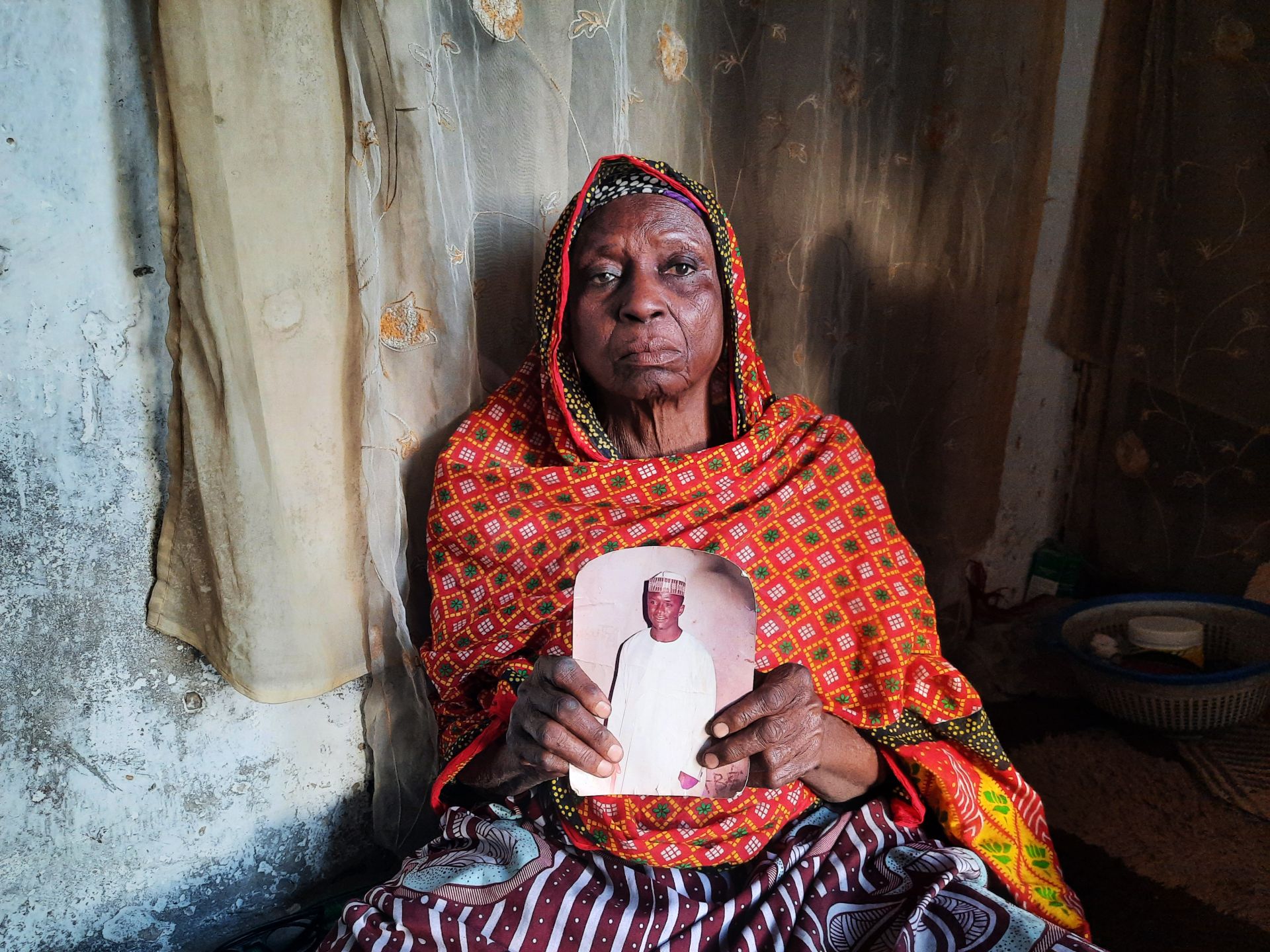Listen to this story
Where must this story begin?
That Saturday morning in March 2013, when Adamu Sa’adu set out for his tailoring shop in Maiduguri, in northern Nigeria? Days later, in an overcrowded detention center where he came face to face with death? Or now, more than a decade afterward, as his father staggers through memories of Adamu’s childhood? The truth is, regardless of how it starts, the story ends with a question mark, a gap into which Adamu vanished, and with the sinking dread that so many with loved ones who shared the same fate know: that the young man’s story likely ends with his body in a mass grave, dug by his own government.
Adamu, 22, headed out early that Saturday morning to the tailor’s workshop in the Gwange area of Maiduguri, where he apprenticed. Crowds had gathered on both sides of the street, one for a wedding and another for a funeral. Suddenly, truckloads of soldiers arrived, breaking up the crowds and carting off over a hundred young men from the neighborhood — all of them suspected of belonging to Boko Haram, the Islamist insurgency plaguing their region — including Adamu.
“Only four of them returned,” said Mallam Uba Sa’adu, Adamu’s father. Others, including his son, never came back — whether dead or alive.
The Sa’adu family’s experience is a window into a pervasive but oft-ignored crisis in Nigeria: Since the Boko Haram insurgency erupted in the country’s northeast in the early 2010s, thousands of people have gone missing in the affected region — over 25,000, according to a 2022 report by the International Committee of the Red Cross, more than a third of all missing persons cases documented on the African continent. A monthslong New Lines/HumAngle investigation has revealed that the Nigerian state — and in particular the military — has helped to drive this crisis, through a campaign of arbitrary arrests, prolonged detention, extrajudicial killings, mass burials and deliberate attempts to obscure their actions. Through interviews with eyewitnesses, satellite data, documents and site visits, we have also uncovered new information regarding the murder and burial of terrorism suspects, indicating that Nigerian state officials violated various international humanitarian laws in their prosecution of the war against insurgents.
Arbitrary and unexpected arrests were common in his neighborhood when Adamu went missing, but they rarely involved so many people at once. At the time, there were still many active members of the Boko Haram terror group spread across Maiduguri, the capital of Nigeria’s northeastern Borno state. People were killed every week, from ordinary civilians to community leaders, politicians, government workers, security agents, students and their teachers. No one was safe. Gunfire and bomb explosions were commonplace. As much as possible, residents locked themselves indoors and security personnel walked in groups. In 2012 alone, according to data compiled by the Nigeria Security Tracker, at least 335 civilians and 92 security agents lost their lives to terror attacks in Maiduguri. Outside the city, the terrorists had broken their associates and other inmates out of prisons and attacked more ambitious targets, including military barracks, the national police headquarters and the United Nations building in Abuja.
Soldiers in Borno state had no foolproof way to tell terrorists apart from civilians; as a result, they treated everyone with extreme suspicion. The Civilian Joint Task Force (CJTF), a militia eventually formed by locals, had yet to spring up to support the armed forces in identifying and arresting members of the terror group. The soldiers, many newly deployed to the area, saw residents as contributing to the insurgency by sheltering the terrorists or withholding information. They were particularly wary of large gatherings. In another part of the city the previous year, military officers had rounded up 15 people during a wedding, according to witnesses. Suspicion was such a powerful force in this period that people hesitated to assemble even to mourn their deceased loved ones, lest they be ushered to join them.
Nigeria has battled the Boko Haram scourge for over 14 years now. The group, which began with the preaching of a radical version of Islam in Maiduguri under the leadership of Mohammed Yusuf, became increasingly violent, especially following face-offs with security forces. Yusuf, a moon-faced middle-aged man and the unschooled child of a security guard father, gained notoriety for his extremist — but well-articulated — sermons in the early 2000s. He spent several years in Saudi Arabia and was inspired by the works of Salafist scholars and ideologues. After the police hurriedly killed him in July 2009, Yusuf’s followers unleashed a hailstorm of violence across northern Nigeria. The crisis is estimated to have killed nearly 350,000 people over the next 11 years, including those who died from food insecurity, poverty, lack of healthcare and other disasters. That is equivalent to filling up Nigeria’s largest stadium, killing all the spectators, and then repeating the bloodbath five more times. Today, 2.4 million Nigerians are internally displaced, according to the International Organization on Migration, and about 8.3 million people need humanitarian assistance to survive across the northeastern region alone.
When the insurgency broke out, the military may have been emboldened by a state of emergency declared by the government in December 2011, and then again in May 2013, which granted security forces additional powers to tackle the threat. Human Rights Watch documented cases of arbitrary arrests, assaults and killings — with some individuals executed in front of their families.
“At the outset of the violence, the police and soldiers in Maiduguri carried out scores of extrajudicial killings of detainees,” the group noted in a 2012 report. “Since then, security personnel have detained suspects at several military and police facilities in Maiduguri, including in an underground detention center at Giwa military barracks.”
Some of the detainees were confirmed to be innocent, either by the army itself or through the courts. Many were simply at the wrong place at the wrong time. It was a war zone, and to survive, the security personnel regarded everyone, especially men, as a potential threat — particularly those living in areas where government forces had been attacked. Many of the arrested men died in detention because of torture or inhumane conditions. Some were taken to the outskirts of Maiduguri and executed, the burden of burying the dead bodies left to residents.
The arbitrary and secretive nature of these events meant that the victims’ families could not verify the status of their missing relations. While most of the atrocities happened years ago, the shock waves they triggered are still present. The tears have not dried. Thousands of families are still waiting for answers and silently praying that their loved ones will return — or at least get some form of justice.
After spending weeks in Nigeria in 2019, the U.N. Special Rapporteur for Extrajudicial, Summary or Arbitrary Executions concluded that though reports of human rights violations in the northeast had decreased, “accountability for violations in the course of the conflict against Boko Haram has not yet been delivered.”
We revisited these horrors through interviews with over two dozen people whose families have gone missing or who witnessed different dimensions of the problem — from arbitrary arrests to extrajudicial killings and the events that followed, including mass burials.
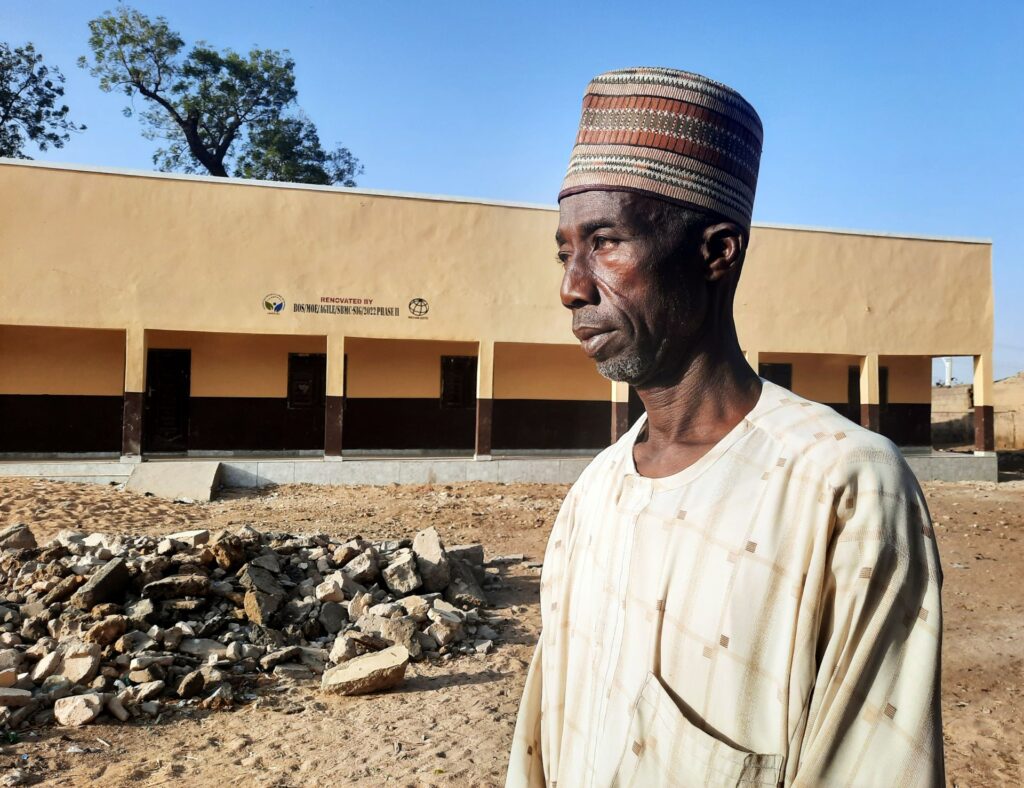
After Adamu’s arrest, his father Mallam Sa’adu went to Sector 3, a military base close to his neighborhood. He took Adamu’s school papers with him to show that the young man had nothing to do with the terror group, which had become infamous for its ideological opposition to Western education. He learned that the young men had already been transferred to Giwa barracks. The officers he met said nothing could be done at that point.
Giwa barracks, one of the few military camps in Nigeria named after a civilian, has become notorious as a place where civilians who are vaguely suspected of terrorism are locked up and starved. Some, through sheer luck, are cleared of wrongdoing and released back into the world, sometimes after several years, left to bear the scars of neglect and torture. Otherwise, they join the thousands of other detainees who have breathed their last breaths inside the barracks’ walls. Amnesty International estimates that from 2011 to 2020, at least 10,000 people died in custody owing to the Boko Haram crisis, “many of them in Giwa Barracks,” according to a report published in 2020.
Mallam Sa’adu learned about Giwa barracks’ reputation the hard way. He could not communicate with or visit his son, but those who were released shared with him the horrors of their detention. While his son was there, prisoners at the barracks depended on a palmful of morsels as their daily rations. Three detainees often shared one cup of water contained in a cloth bag. At one point, because the food was made so scarce, they were forced to eat orange peels and eggshells. They convinced themselves that it was like cabbage, a fellow prisoner later told Mallam. From noon to 1 p.m., the military authorities let them out of the cell to roam the premises. This gave them an opportunity to scavenge for the soldiers’ leftovers, including the peels and shells.
On the morning of Friday, March 14, 2014, Boko Haram played a card that changed many lives forever. Its men, armed with assault rifles and gun trucks, broke into Giwa barracks.
Abubakar Shekau, the group’s now-deceased leader, claimed that they freed over 2,000 associates, most of them commanders, during this attack. Other detainees escaped too. In the aftermath, soldiers and vigilantes hunted down and summarily executed hundreds of unarmed escapees. According to a 2014 Amnesty International report, more than 600 people were killed in different parts of Maiduguri during this crisis. Many of them were buried in at least three mass graves. Videos seen by HumAngle show that some of the victims were forced to dig vast pits. The security agents then laid them at the edge, one after another, and slaughtered them with crude machetes.
Mukhtar, who lives close to Giwa barracks, witnessed some of the murders. When he stepped out of his house that morning, he saw two armed Boko Haram insurgents entering an unfinished building. He heard gunshots. After some time, when he felt it was safe, he dashed out toward the city center with his wife and two children. That was when he saw it.
“As I was passing the Jiddari Polo area, I saw corpses and freed detainees. They kept a large number of them under a water tank. The CJTF and military killed them with guns, machetes and other weapons,” he recalled. (Like many of the sources in this story, for whom speaking out would compromise their safety, we have changed Mukhtar’s name.)
He saw six corpses at first and witnessed the killing of three more people, mostly men he estimated to be in their 20s or 30s. In this area alone, Amnesty International reported a death toll of more than 190. As Mukhtar made to leave, he saw the security agents bring in even more people. He recognized one of the faces, a young man from his neighborhood who worked with politicians. Mukhtar maintains that he was not a Boko Haram member, “but they killed him.”
“I am always thinking about it because some of them were innocent,” he said. “They kept saying that they were not Boko Haram, that they were innocent detainees, but the soldiers wouldn’t listen.”
Shekau, the Boko Haram leader, confirmed the fears that many of the victims were indeed civilians in a statement he released days after the raid.
“The people you killed in the town were among the freed prisoners, but they were not our brothers,” the terror leader said. “They were freed but thought the town was still the way they left it, so they left their short [prison] knickers on and were heading home when you apprehended them. You thought they were our brothers, so you killed them.”
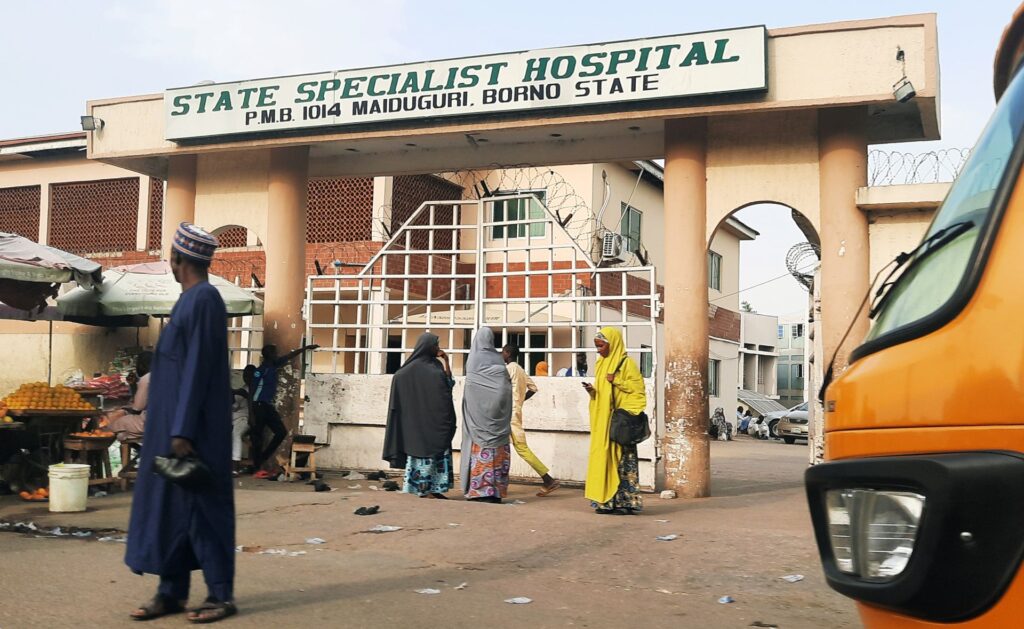
Adamu may have been one of the victims. His cellmates who made it back alive told his father that he was. But Mallam Sa’adu’s mind entertained the possibility that he might still be alive. Maybe he was injured, admitted to a clinic somewhere. So, he went to the Borno State Specialist Hospital, where he saw scores of corpses transported in garbage trucks from the mortuary to the graveyard.
“They dug massive holes in the ground around the university. Then they dumped them all in it and covered it with sand,” he said.
Mallam Sa’adu did not witness the mass burial, but his friend, a government worker who was there, told him what had happened. He had been searching for his own son and had gone to confirm if he was among those killed. He said it took more than one truck of dead bodies to fill the graves, known as “karo kuka” (literally “increase tears”) in Hausa. Some people were taken there alive and then shot and buried. Mallam’s friend said he saw Adamu’s body, but since they did not see it for themselves, the Sa’adus are still keeping hope alive — even if just a glint is left.
Mallam Sa’adu doesn’t think he could have done anything differently to protect his son.
“All I could have done, I have already done,” he said. He sent his children to stay with their grandmother in Potiskum, in neighboring Yobe state, when the crisis got heated, only inviting them back months later when there was relative calm. He was confident they had nothing to do with Boko Haram and did not expect they would ever face such accusations.
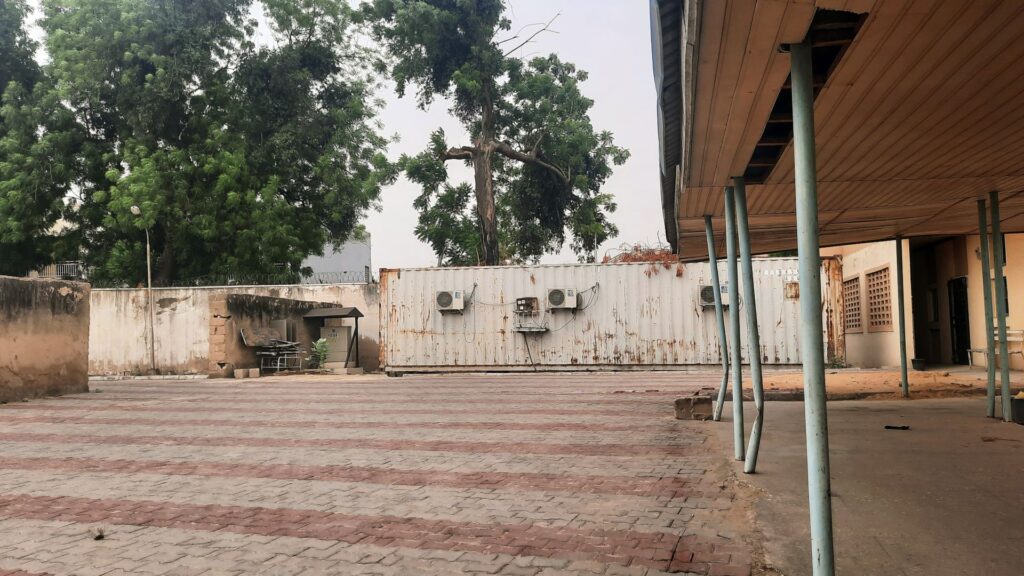
Many casualties of Nigeria’s counterterrorism operations were not treated with dignity, even in death.
When the insurgency broke out, corpses transferred to the mortuary by the military were well documented. Zayd, a health worker at Borno State Specialist Hospital, where the corpses were delivered, told us that for each corpse, Giwa barracks would bring a cover letter containing the name, age and address of the deceased. There were as many letters as there were bodies. One copy was kept by the hospital and another by the military authorities. The hospital would hold on to the bodies for about a week before calling the Borno State Environmental Protection Agency (BOSEPA), which picked them up to be buried in Gwange cemetery, where there is a designated section for Boko Haram insurgents. This was the protocol.
But then, the number of corpses started increasing from several a day to as many as 10 or 15. The military stopped bringing one letter per dead body and instead listed the names of all the bodies on one document, making it impossible to tell who was who.
After the crisis had intensified, during one of their usual deliveries, the military personnel asked the mortuary attendant for all the previous documents and left with them, the worker recalled. They stopped bringing new documents afterward. New Lines/HumAngle confirmed this incident from multiple sources within the hospital. One of them recalled that the lack of proper documentation started in early 2013.
Mahmud, a former hospital worker assigned to the morgue, said the families of victims used to be allowed to retrieve and bury the bodies. Later, the military cut off this access entirely, he said. They also assigned a unit of soldiers to the hospital to ensure no unauthorized person entered the morgue. “They said human rights campaigners started talking about it and came and took pictures,” Mahmud said. But by preventing people from visiting, he added, the security forces also kept families from determining whether their relatives were among the dead.
The hospital’s resources were often stretched too thin. There were times when the morgue’s refrigerators, which have a maximum capacity of 150, could not take any more bodies and the corpses were left outdoors “like slaughtered meat,” one of the workers said, for a week, maybe two. If the bodies started to decompose, the hospital spent as much as 100,000 naira (at the time, close to $500) a day to buy cleaning materials and pay people who would clean the morgue.
“We were scared” of what might happen, Zayd said, “if there was rainfall or flooding, since the mortuary is very close to the pediatric ward and innocent children were on admission. If there is any outbreak, what are we going to do?”
Documents leaked to us from hospital records showed that between June 2013 and November 2022 there were 3,326 corpses deposited at the facility’s mortuary by soldiers from the Giwa barracks. In the first two months, an average of 26 dead bodies were brought on a daily basis, after which there was a general drop in the figures. Many days went by without incident. Others saw dozens of corpses arrive from the detention center. We checked the figures we received from the health facility against press reports of terror attacks, bomb explosions and extrajudicial killings in Maiduguri and found that they correlated.
There have been significantly fewer cases since 2018, but the bodies still come. The last one came on Nov. 21, 2022, which was just five days before we received the data compilation.
It was not only the military that came with dead bodies; the police did too. In the same nine-year period, they took 801 corpses to the state hospital. However, the bodies from the police were often unidentified casualties of bomb explosions, accidents and terror attacks — their bodies bore shrapnel or gunshot wounds, or other injuries that gave insight into how they’d died.
But those from the military usually did not, indicating they might have died from starvation, overcrowding or some aggravated illnesses. “They said they had been poisoned,” Zayd said, about a day the hospital received over a hundred corpses.
Dr. Yahya, a government physician, suggested that many of the deaths in the barracks were due to starvation and hypoxia — a lack of oxygen and an oversaturation of carbon dioxide — caused by overcrowded cells. Prolonged hypoxia can lead to organ damage and, ultimately, death. The poor quality of food contributed, too.
“One baba [old man] was telling me they gave them food in their hands and a cup of water for a whole day,” he recalled. “He said the food was highly salty, and he was hypertensive. He couldn’t eat it. He didn’t need much food as an old man, so he would give it to the younger ones in exchange for water.”
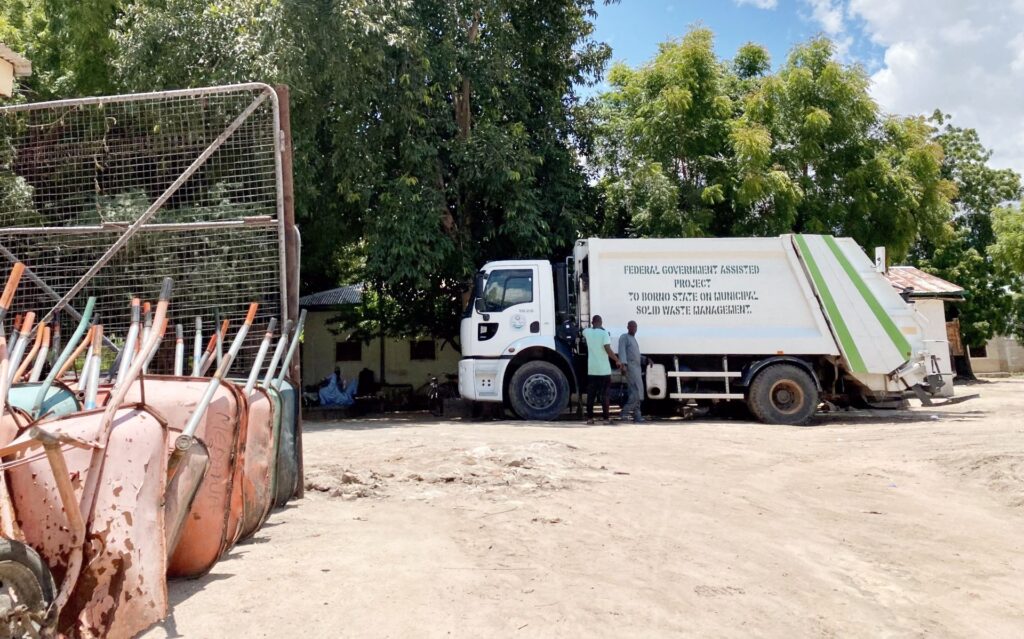
One of the worst jobs a person can have in a conflict zone is tending to the wounded and the deceased. Musa, a former mortuary attendant at the state hospital, blames the unusual workload for his deteriorating health. He has enduring back pain from lifting so many corpses and an eye defect from constant exposure to disinfectants.
Even before the insurgency, the work environment was difficult. The freezers hardly cooled because of the poor supply of electricity, and the attendants worked long hours in the choking miasma of decomposing bodies. Some bodies stayed in the morgue for up to two months without anyone coming to claim them.
Before the war, they received from five to 10 bodies every day from within and outside Maiduguri, of people who had died in all sorts of circumstances. But after the war broke out, “it was crazy,” Musa said. “Sometimes, we got like two tipper trucks filled with bodies offloaded at the mortuary. I used to work all night conveying corpses, especially after bomb attacks.” The military ambulance can hold 70 bodies at a time, he said. On some days, it made up to three trips to the hospital. And then there were still the corpses deposited by the police. In spite of this, the attendants continued to receive their old monthly salary of about $40, with no additional allowances from the government.
Describing the bodies from the military, the retired hospital workers said they were mostly men aged between 25 and 30. Occasionally, they saw boys, possibly as young as 15. Mahmud said he had seen at least three children not more than 18 months old. They showed signs of malnourishment or measles. Some of the bodies had no heads and some looked like they had been skinned. The skins usually peeled off as the bodies were moved because they had been kept in heated, overcrowded cells. Some were unclothed, their genitals exposed. Others looked like they had worn the same clothes for several years without taking them off once to be washed.
Those with gunshot wounds — not so many — were usually brought in at midnight. The soldiers hardly spoke. But whenever they brought bullet-ridden bodies, they often explained that they were Boko Haram suspects.
“If not that I got used to things over time, I wouldn’t have survived. When they first started bringing the corpses, I didn’t sleep well for three years,” Musa told me.
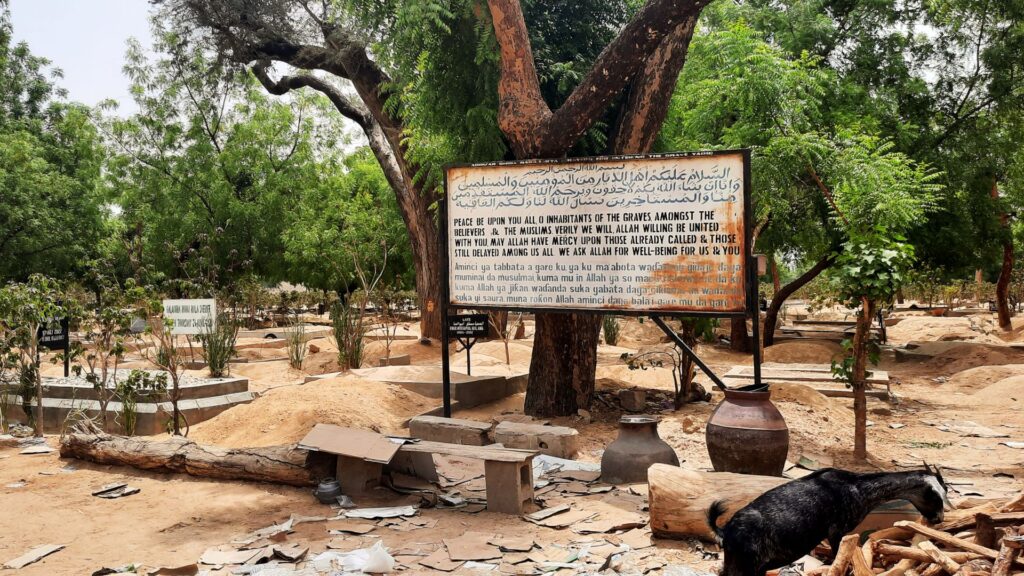
From the morgue, bodies were taken to the Gwange cemetery by BOSEPA garbage trucks. The military blocked the roads to the cemetery to keep the public out. Though only BOSEPA staff were allowed inside, people could still see the stacks of bodies inside the trucks from a distance. The putrid smell was unmistakable. Such burials were frequent from 2011 to 2014.
Nasir, a former BOSEPA worker, said that there are no mass graves at the Gwange cemetery. There were days they buried hundreds of people in a day, he told us, but they made sure each grave was dug separately before they started. This meant they had to work from 8 a.m. to 6 p.m., only taking brief breaks to get something to eat.
“We bury them one by one,” he said. “They don’t allow it, nah. Even those working inside the graveyard don’t normally allow it. It is against the law of the religion [Islam] that you bury two to three people in the same place.”
The rights advocates and CJTF vigilantes we interviewed, however, insisted that several people were often dumped inside each small grave. One definition recently adopted by U.N. special rapporteur Agnes Callamard is that mass graves are burial sites containing the remains of two or more victims of extrajudicial, summary or arbitrary executions.
To corroborate these reports, we sought out satellite data that could shed light on how these individuals were buried. (Read the full report on how we used open source data to uncover mass graves here.)
We found four sets of satellite images showing what appear to be piles of dead bodies at Gwange cemetery from August 2014 to December 2015. Based on the size of the heaps and the fresh gravesites that followed, we estimated that there were from 381 to 405 bodies.
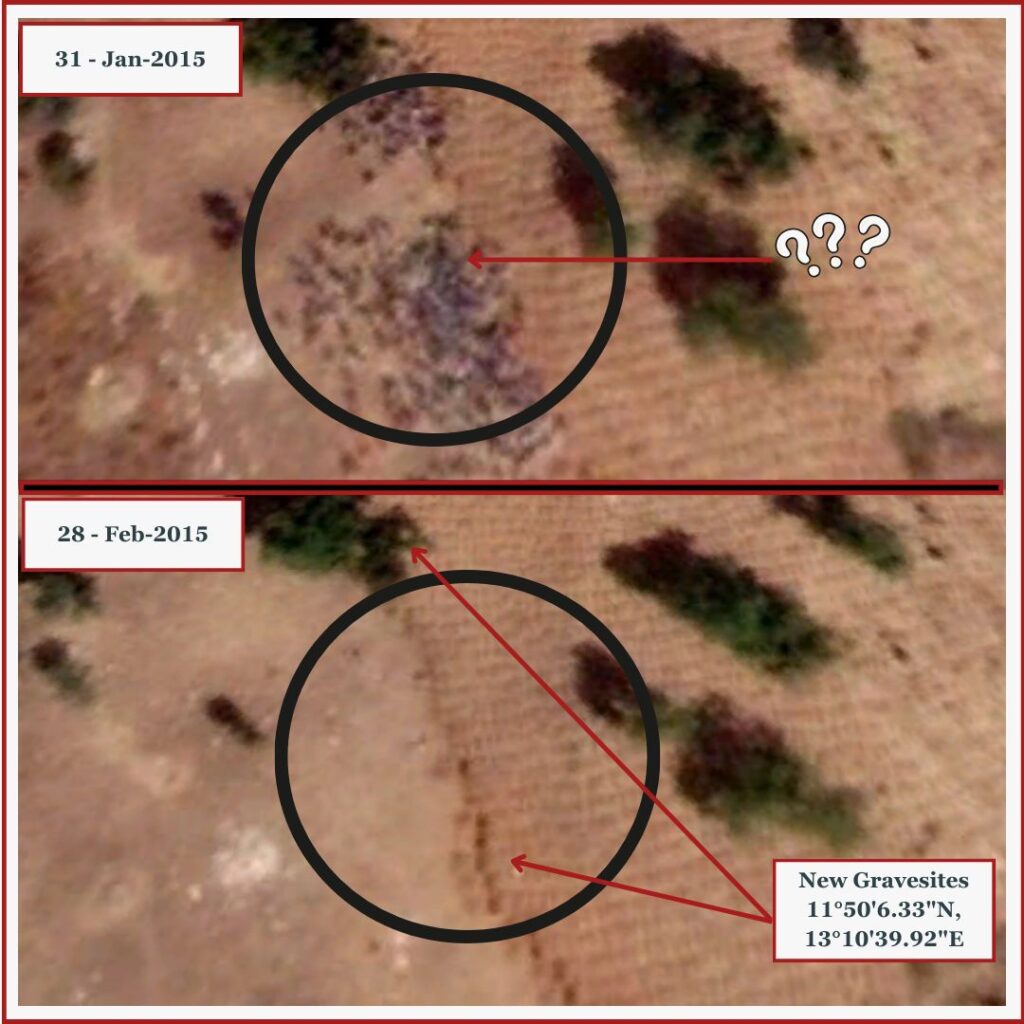
Nasir, the BOSEPA employee, confirmed that officials created mass graves in other parts of town, away from the city center. Dead people were abandoned in different parts of Maiduguri. Because the agency was understaffed, he explained, it would be difficult to gather and bring them all back to the cemetery. So they moved around with a backhoe truck loader, picking up the bodies one by one. When the plate on the front of the loader was full, they dumped them into a flatbed and took them for burial in mass graves dug with excavators. But “it is only the graveyard we know,” he added. “I didn’t follow people who have been doing it on the road.”
He estimated that each truck could transport from 180 to 190 bodies. Sometimes, they had to bury several truckloads of corpses. And if there were any left by evening, they would return them to the morgue and continue the following day.
There was no way to wash the bodies, as is customary in Islam before the deceased is buried, because many had already started to rot. Some had started to swell. They had been dead so long that you could not firmly grip them if you tried. The hairs came off when they were lifted using hands wrapped in plastic bags. There were no prayers either.
“Where is the time for prayer in this type of situation?” Nasir scoffed.
Another flaw with the burial process was the lack of proper documentation. Though Nasir says each corpse had its own grave, no names or locations were recorded along with the bodies. It was impossible to locate and exhume, say, the body of a “Yusuf Abubakar” if the need arose. The burials of corpses brought by the military were random and those that came in bags had no names attached.
“They write just Boko Haram. No name. They always put ‘BH.’”
This way of disposing of the dead violates international humanitarian law. The Geneva Convention, to which Nigeria is a signatory, stipulates that prisoners of war who die in captivity must be honorably buried — if possible, according to the religion they practiced. Their graves should also be “respected, suitably maintained and marked so as to be found at any time.”
When we contacted BOSEPA spokesperson Garba Kallamu for comment, he replied that only the agency’s general manager could authorize interviews with the press. The general manager was unavailable when our correspondent visited and has yet to respond to inquiries delivered through a letter.
Not all of the 2014 Giwa barracks massacre victims had the good fortune of being transferred to the morgue. Many did not make it that far. They were simply dumped by the roadside or in other remote areas.
Sheriff Abba is a retired civil servant who regularly traveled to Monguno, about 80 miles north of Maiduguri, to maintain electricity supply lines between 2004 and 2014, and saw more than his fair share of the insurgency’s dark side.
Because he drove a car himself, he could slow down to have a closer look at the dead bodies discarded just off the road. He says that, through the years, he saw too many corpses to be counted. Some were rotten and exposed to harsh weather for a long period.
“We usually sensed they were disposing of the dead bodies when traffic ceased. You would see the dead bodies by the roadside when the road was reopened.”
The incidents were especially common in 2013 and 2014.
“I have seen one, two, three, five, 10 and even 20 bodies at times. There were instances where the military would come and kill them in our presence, especially in Gajiganna when we were repairing broken high-tension utility poles. It was during the peak of CJTF arresting Boko Haram; they took them to the military and the military would execute them near the place we were working.”
Abba said he saw from eight to 10 such executions. His team would take it upon themselves to bury the bodies so as not to be disturbed by the stench. Thankfully, they always had digging materials with them for the repair work. He said he had been part of five such burials. Squinting his eyes as if it were returning to him, he said he still remembers the smell.
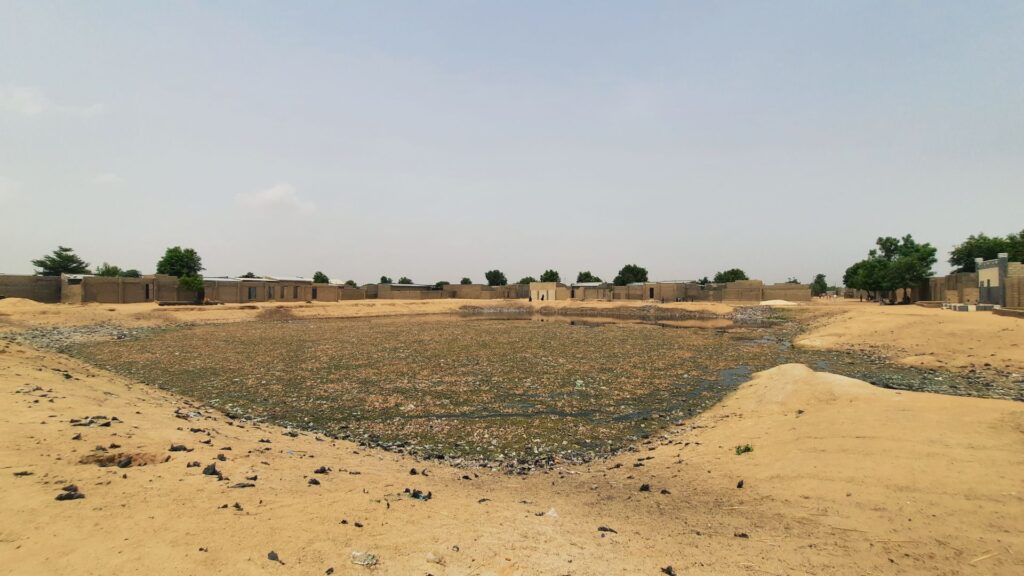
Another human dumpsite was in Kalleri, a community about 30 minutes’ drive from Maiduguri. After Boko Haram attacked a military base in the area in July 2011, security forces went from house to house, shooting people and burning down residences. Amnesty International reported that year that at least 25 people were killed, but Bako, a high-ranking vigilante living in Maiduguri, told us he knows of 42 victims, including a primary school headmaster who had shown those responsible his identity card. The assault lasted from 11 p.m. to dawn, he said. Locals were forced to flee. The area became deserted for some time, and the military dug trenches around it to prevent further attacks on its camp by terrorists on motorbikes.
In 2013, people started to resettle back in Kalleri. But what awaited them was grim.
“When you raise your head, about 100 meters from where you are standing, you are seeing corpses, bones of corpses,” recalled Aminu, who visited the area just after inhabitants started to return. There were also a lot of dogs; they saw not a staggering tragedy but an opportunity to fill their bellies. As the wind blew, it carried hairs from the corpses to where Aminu stood, and he wondered why no one had bothered to bury some of the bodies properly. Many had decomposed and only bones and skulls remained, but others were fresh.
Abba, the former civil servant, said he has no pity for the people executed or dumped by the roadside, believing most of them to be terrorists. He had seen Boko Haram kill travelers several times. “There was a time they hunted down one man in Gajiganna market and several people were incidentally killed,” he recalled. One of his colleagues, Bala, was also murdered by the terror group. At night Bala guarded a cellphone tower, and during the day he volunteered with Abba’s team. One day, Boko Haram set fire to the tower and, because he had dared put it out, they killed him and a second guard.
“Boko Haram has caused a lot of suffering. They have killed many people themselves. So, I don't pity them.”
He believes all those captured and killed by the military in the Gajiganna area were truly terrorists, arguing that it is a small town and people knew those who were members of the insurgent group.
But many innocent people have also been caught in the crosshairs.
Last year, the Legal Aid Council secured the release of 101 individuals who had been detained since 2009 after they were profiled as Muslims in Bauchi, Borno and Kano states. The court struck down the cases against them. From monitoring mass trials of detainees in 2018, Human Rights Watch noted that nearly half of the defendants were either acquitted or discharged because there was no case against them. Amnesty International has alleged that many of the security agents’ arbitrary arrests were “largely based on random profiling of men, especially young men, rather than on reasonable suspicion of having committed a criminal offense.” In 2021, the Nigerian Army cleared over 1,000 detainees for release from Giwa barracks and the Maiduguri Maximum Security Prison — itself confirming to local media that they were “not implicated in terrorism and insurgency.”
We spoke to two CJTF officers for this story, but they denied being involved in the extrajudicial murders. One sector spokesperson said they only captured Boko Haram members and handed them over to the military, making sure to arrest only those seen with arms.
But one video from 2014 obtained by HumAngle suggested that CJTF personnel actively participated in the killings. There are six officers in the video, three wearing army uniforms and the other three in plainclothes. The recording starts with the slaughter of a young man. He is laid at the edge of a grave. The soldier wearing a camouflage T-shirt steps on his legs. One plainclothes officer holds his head in place. Another locks his hand between his thighs while the second soldier, wearing a tactical vest, slices his neck. When the slicing stops, the second plainclothes officer waits a few seconds and then kicks the man into the grave. “Let’s go! Let’s go!” the man behind the camera says, pumping up his colleagues. There are at least 14 other men waiting in line, some looking disturbingly young. “Next!” someone cries. Taking the cue, a middle-aged man in a white boubou stands up and approaches his certain death. In the meantime, the camera pans to the grave. We soon see why. The man who had just been pushed in is still alive, writhing and wheezing.
We shared our findings with army spokesperson Brig. Gen. Onyema Nwachukwu, who declined to comment on the investigation. Letters sent to the Defense Ministry and the army also went unanswered.
In a previous interview, Nwachukwu told HumAngle that the army does not detain innocent civilians. “Why would you say we are detaining innocent people? We are to defend the people. That is what we are there to do. It is a legitimate operation we are conducting against terrorists and insurgents in the northeast and not against victims of conflict,” he said.
We repeatedly reached out to CJTF founder and Chairman Ba Lawan Jafar for comment, but he is yet to answer our calls or reply to texts sent to his phone.
In May 2023, we visited 15 sites within and on the outskirts of Maiduguri, which our sources told us were used by the Nigerian military for mass burials, particularly between 2012 and 2015. Satellite image analysis of some of these coordinates showed signs of soil disturbances consistent with mass burials.
Because of the difficulty of finding images of the region from the period when the events took place, we additionally relied on synthetic aperture radar (SAR) satellite information from NASA. Unlike conventional satellites that use light, SAR satellites use microwave energy that allows detection of surface changes and subtle variations a few feet below the ground.
We observed subsurface disturbances, for example, in multiple places in Moduganari Bypass, which used to be a thinly forested area surrounded by fewer structures. One source, a resident who lived in the neighborhood, estimated that between 100 and 150 people were buried in one of the spots and at least 70 people in a second spot in the same area between 2011 and 2012. The areas our source pointed to match exactly the places with signs of burial, according to satellite data analysis.
Radar assessments of some of the locations confirmed the possible presence of mass graves. At one site inside the University of Maiduguri, radar measurements captured shallow ground disturbances in the area close to a trench. The extrajudicial murders that took place at this location were some of those filmed by security personnel in 2014.
Thousands of arrests took place, especially from 2011 to 2016 — it’s impossible to tell just how many. If the security personnel were fishers, they favored using nets rather than fishing poles and often trapped the wrong catches. In the early days of Boko Haram’s uprising, soldiers swept through neighborhoods in Maiduguri and arrested many adult male residents. In other cases, vehicles in transit were stopped and the passengers were arrested. More commonly, people displaced from communities across the state where Boko Haram was present were profiled and locked up based on one argument: If you are not insurgents or Boko Haram allies yourselves, then why didn’t you leave your hometowns earlier as soon as the terrorists invaded? But, of course, it’s not that simple.
Aside from the torture of being torn away from the only place they called home, many people caught in such circumstances explained that there were no opportunities for escape. The terrorists usually killed anyone they caught trying to leave. So they devised different ways to avoid detection: sneaking out of town after nightfall; men bundling together and traveling separately from women; men wearing the burka and disguising themselves as women; trekking longer distances away from the main roads; leaving whatever vehicle they had in the village. But after all these sacrifices and a dreary journey, thousands of men still fell into the waiting mouths of sharks in military fatigues.
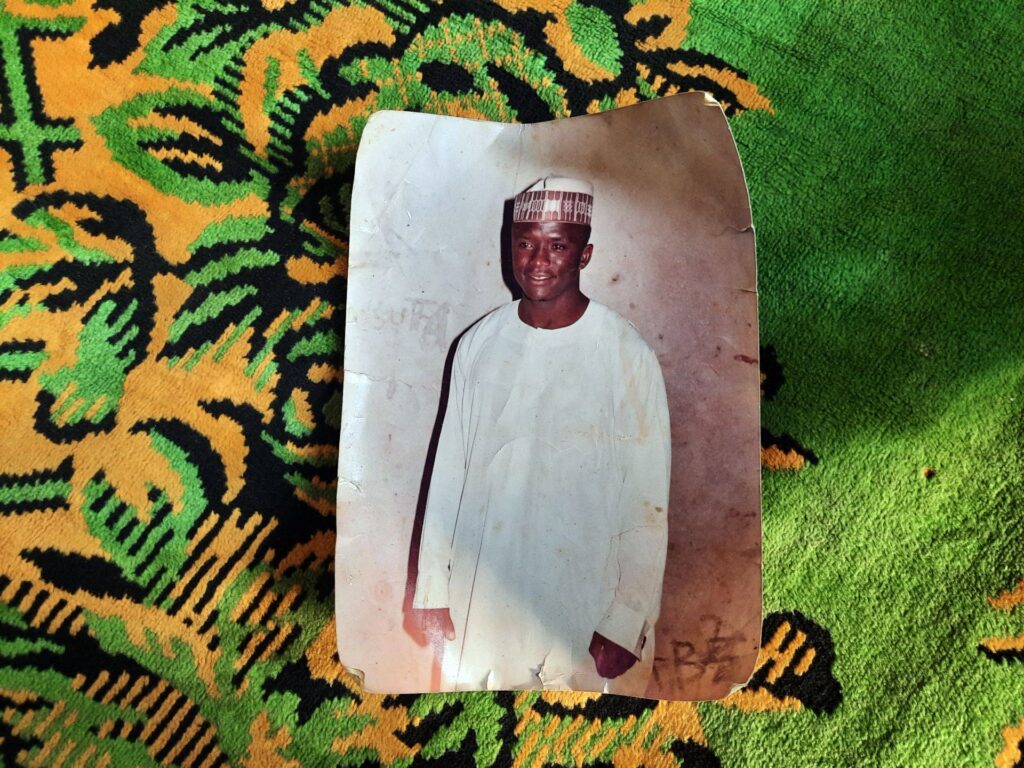
Eleven days into Ramadan in 2013, at 7:30 a.m., Usman Modu heard a knock at his door. His children were fast asleep after having had an early breakfast. Some were stirred awake by the knocking. When Usman answered the door, he met officers of the CJTF and the army waiting outside. They asked him to come with them. He found that other men had already been gathered outside on the main road. That day in Modu Ganari, a residential neighborhood at the heart of Maiduguri, over 70 men were arrested. Only six returned — and Usman was not among them. His mother, Hajja Zahra Modu, recounted the day and the seemingly random group of men arrested. “Some were students; some were the breadwinners of their families.”
A few blocks away, earlier that same morning, another round of knocks was heard. It was the house of Hawwa Abubakar. The security personnel led away her son, Yama, who was 25 at the time, after interrogating him about potential Boko Haram affiliation.
“His father died when he was 15,” Hawwa said. “So, after he finished secondary school, he became a bricklayer. He cared for us. After a whole day’s work, if all he got was 200 naira (about $1), he would split it in two and hand me 100. He always said it was his duty to provide for me.”
She had given birth to 12 children, but only three survive — Yama and two daughters — or at least she still maintains that hope. She, however, hasn’t heard anything from or about the young man since 2013.
The same year, there was another military sweep in Gwange Kukan Bori, also in Maiduguri. The sons of Hajja Yagana and Firuwa Usman were arrested at a tea shop alongside 13 others. Abdussalaam Muhammad, who was only 12, had gone there for breakfast and never returned. Abba Damba, also 12, had gone to buy bean cakes while on his way to Quranic school when he was picked up.
Both children were taken to Giwa barracks.
The bulama, or village chief, of Kukan Bori, a man named Ali Zarami, was also shockingly arrested in 2013. His mother, Zara Ibrahim, said it was because he challenged the CJTF’s allegations about two young men they suspected of being members of Boko Haram.
Soon after, the vigilantes returned, saying he should follow them in his car to testify about some suspects. Then they accused him of using his position to aid the release of Boko Haram suspects and handed him over to soldiers, who locked him up at Giwa barracks. He has not been heard from since. “And those two boys [he defended] are still around; they have not been arrested since then,” says Zara, suggesting he was right about them after all.
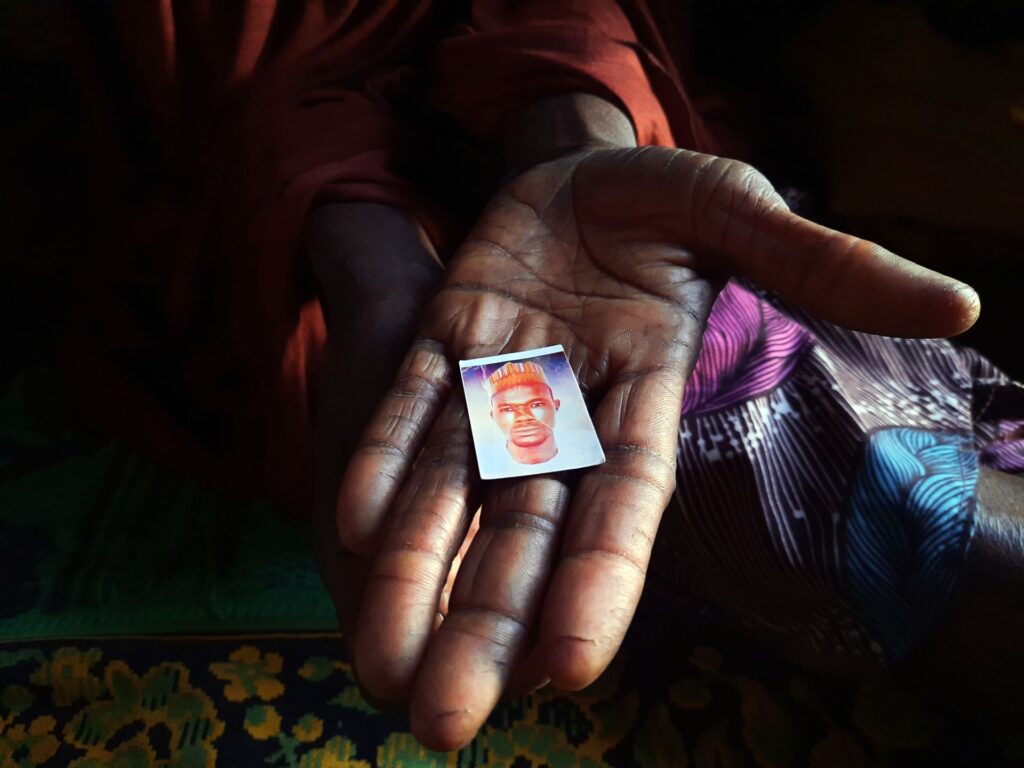
After the killing spree that followed the Giwa barracks jailbreak of 2014, many people who had family members detained at the facility went about searching for them — hoping to at least identify their corpses. A few were successful. Many others only hit dead ends. Hajja Yagana, for example, said she visited the state mortuary and different sites of extrajudicial killing. Shortly after Abdussalam was arrested, he sent word back home through a former detainee that he was at Giwa barracks. But since the incident in 2014, his family has not heard from him.
One of the reasons people could not search for their missing relatives during the crisis was the risk involved. We gathered from multiple sources that soldiers fired at those they caught visiting sites where dead bodies were prominently piled up.
“This stopped many people from going because they didn’t just want to go there in search of a dead body and then they would also become a dead body there,” Aminu said. “So they are never sure whether the person they are looking for is there or is in the barracks or elsewhere.”
The record of how many people have been arrested over the years in connection with the Boko Haram insurgency is not publicly available. As of August 2021, there were still over 2,500 people held at Giwa barracks, which is only one of several detention facilities. Amnesty International estimates that the civilian death toll at the barracks from 2011 to 2020 is at least 10,000.
While these people are in detention, their families are left to scuttle after any sign of hope. New Lines/HumAngle has received several accounts of purported military officers and other security personnel exploiting the desperation of people with family members in detention centers. They would promise that they could secure their release. But first, they had to be paid hundreds or even thousands of dollars. And then they would be unreachable, keep asking for more money, or simply claim that the person later passed away.
It is hard to call the Sa'adu family fortunate; their son, cut down in his prime by his own government, will never again grace their home with his laughter and warmth. But the Sa'adus have, at least, a small sense of closure, having heard from former cellmates and their friend in local government that Adamu is, more than likely, deceased. Not all the families of people detained at the barracks are as lucky, and the mystery remains: Are their loved ones alive, in squalid conditions, living on eggshells and orange peels? Or are they dead and buried, unshrouded, in a trench for terror suspects?
Though Nigeria is not the only country in Africa facing a protracted insurgency, according to the International Committee of the Red Cross it has the highest number of missing persons on the continent. Why is this?
Beyond the extrajudicial killings and arbitrary arrests by state agents, the lack of transparency in the criminal justice and counterinsurgency processes has worsened the problem. When deaths are recorded, they are treated as footnotes of war, not worth acknowledging. After what happened in March 2014, for example, Adamu’s family did not receive a visit, an invitation or correspondence from the government acknowledging their son’s death. “It’s like they just killed a lizard or a dog or something,” Mallam Sa'adu reflected.
In violation of the Geneva Convention, detainees are also not allowed access to lawyers or their families in many of the detention facilities, which keeps their loved ones in the dark about their status. Some have been in custody without trial for over eight years. It is unclear why thousands of people are still kept in detention centers on suspicion of supporting terror organizations when the same government has accepted thousands of “repentant” insurgents into a deradicalization and rehabilitation program and then reintegrated many of them without prosecution.
The army tries to absolve itself by rightly arguing that it is not its job to prosecute suspects. Just a fraction of those held in detention have been tried. In January 2022, however, the attorney general of the federation, whose ministry budgeted millions of dollars for the prosecution of terrorism suspects last year, promised to resume the trials soon, blaming the delay on the COVID-19 pandemic and a rise in terror attacks.
Abductions by Boko Haram contributed to and in many ways drove the crisis as well. The insurgent group would conscript young men and abduct young women, their family members never hearing from them again.
Much like Schrodinger's cat, they are torn between two main possibilities. But unlike Schrodinger, the families have no means of confirming the trapped entity’s status. And so, they, too, are in a cage, eternally trapped in this conflict of simultaneously possible misfortunes.
On Aug. 4, we wrote to the Nigerian army and the Ministry of Defense to share our findings. We also asked if the authorities plan to disclose the identities of people held in various detention facilities and those who died while in detention, in line with international laws. We shared the names and details of 197 people who we confirmed went missing after they were arrested by security agents and asked for their status.
We have yet to receive a response. We have, however, learned that since we shared the findings of our investigation with the army, detainees held at Giwa have been granted, for the first time in years, access to call family members, a major step in helping families find their loved ones and, eventually, reunite.
Maiduguri-based development worker Comrade Ahmed Monguno believes many in the community are silently displeased with how the state has handled the burial of people arrested by security forces — secretly and without complying with local traditions. The bodies should at least be shrouded, he said, and if they cannot be washed, some water should be sprinkled on them. A cleric should also be invited to pray for them before they are buried in separate graves.
He added that, just as with arrests, each death should have been documented, including the person’s name and picture. Then the government should condole with the family, explaining why the family couldn’t be allowed to handle the burial.
The government should apologize for past wrongs and assist families in reuniting with their loved ones, he suggested. It should get information from former insurgents about those of their associates or captives who are also considered missing and share this with the affected families.
“A committee should be set up to go around the detention facilities, and any person who was arbitrarily arrested should be released,” Monguno said. “The government has even forgiven those who carried guns, let alone somebody who was living peacefully. And if it confirms that a person who was arrested is no longer in the barracks, the government should compensate and condole their families. It should tell them that those children of yours were not established criminals, they were arrested on suspicions and based on certain information given, but they were unfortunately killed.”
Various international treaties and frameworks support Monguno’s suggestions.
One of those is the International Convention for the Protection of All Persons From Enforced Disappearance, which Nigeria has ratified, which tasks countries to “take all appropriate measures to search for, locate and release disappeared persons and, in the event of death, to locate, respect and return their remains.” Another, the Minnesota Protocol, a U.N.-penned handbook about potentially unlawful deaths, also requires governments to investigate such fatalities and prosecute perpetrators. It states that victims have a right to remedy and that family members of missing people have a right to information on what (may have) happened to them and “the right to know extends to society as a whole.”
“In the event of death,” the protocol adds, “all parties must use all means at their disposal to identify the dead, including by recording all available information prior to the disposal of the body and by marking the location of graves.”
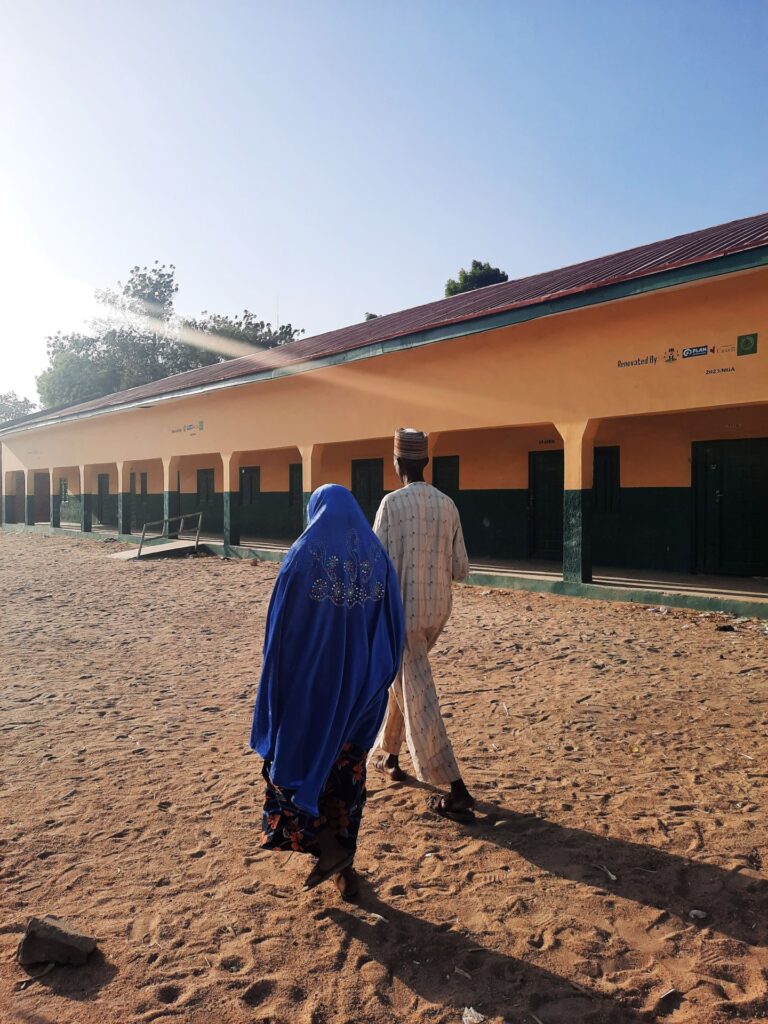
Adamu’s story doesn’t end with his body in a mass grave.
His arrest and death caused a ripple in his family that haunts them to this day. His parents became hypertensive. His mother, Saratu, nearly lost her eyesight; Mallam Sa'adu thinks this is because of her prolonged illness and from all the crying.
“We’ve gone to over 10 eye hospitals,” he told me. “But she still can’t see well. All they do is give her more drugs, and it hasn’t been working.”
Saratu speaks more about the possibility of Adamu being alive than does her husband, who seems to have made peace with the certainty of his death.
“I pray that he comes back safely to me if he is alive, and if he is dead, I pray Allah forgives him,” she said. She is even more heartbroken because she was the one who encouraged him to learn tailoring. She took him to that workshop in Gwange, where he was arrested. Despite the doctors’ advising against her crying, her eyes still well up when she thinks of him. But she tried her best to fend off the tears.
Mallam Sa'adu started to cry as he talked about his son’s dreams of becoming a banker or accountant, which now lie in the soil with him. His voice broke like it had suddenly lost all moisture and his eyes reddened. After Adamu’s arrest, he had gone to his son’s university to defer his program in the hope that he would carry on the following year. It never happened.
“He enjoyed playing street football,” Mallam said. “He started taking up some responsibility in the house. He’d buy us yam sometimes and bring it home, so we’d prepare it and eat. Sometimes he’d get us rice. He would provide for us, not just for me, but for my mother too and my relatives. He would visit them regularly and give them money. All he had ever wanted to do was to help us. That’s what he’d always said, that he wanted me to get some rest after all the hardship I had endured to raise them.”
Anytime Adamu’s memory creeps up, it never fails to evoke tears and pain from his loved ones. Sometimes, his parents reached for his photographs to remember the version of him before the dark days. Mallam Sa'adu likes two especially: one he took with his friends at the secondary school and another he took during Eid in front of a swimming pool at the Sheraton Hotel, again in the company of friends.
Mallam Sa'adu is not only pained that Adamu died unjustly when he had so much to live for; he is also hurt that he did not get a chance to see his body and conduct a proper burial. He said he would appreciate it if there were a way to make that happen.
He wants justice, and for him, that means for the government to pay the diyya — financial compensation paid under Islamic law to families by those responsible for a homicide.
“Some kind of help that will lift some of the weight off our hearts,” he said. “The help can be in the form of cash or foodstuff; this will help us.” In his own case, for instance, he had to sell two plots of land to raise money to send to Adamu every week while he was in prison and for the family’s upkeep. With medical expenses piling up too, their tough days are not over, and paying for basic things such as the children’s school fees is a struggle.
But more than anything, he wants the government to own up to its crimes.
“They should say, ‘We made a mistake and we are seeking your forgiveness.’ The military should come out to acknowledge what happened and apologize.”
This investigation was a collaboration between New Lines magazine and HumAngle, and was published in the Winter 2024 print issue.
Sign up to our mailing list to receive our stories in your inbox.



